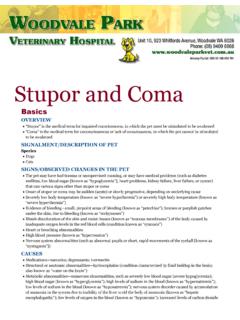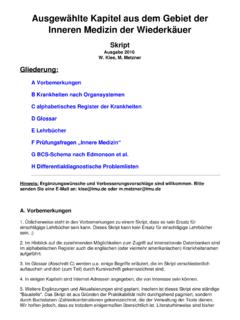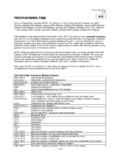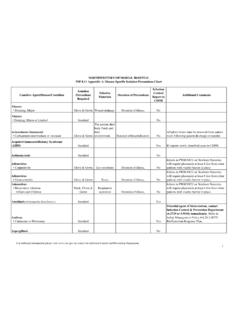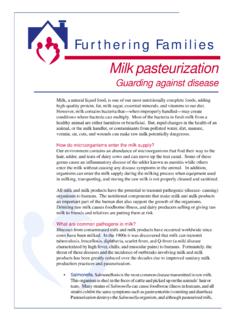Transcription of Hemorrhagic Gastroenteritis - Woodvale Vet
1 Hemorrhagic Gastroenteritis (Sudden, Bloody Inflammation of the Stomach and Intestines)Basics OVERVIEW Very sudden (known as peracute ) bloody inflammation of the intestines (known as Hemorrhagic enteritis ) ofdogs, characterized by a sudden onset of severe bloody diarrhea that is often explosive; the dog also hasvomiting (therefore, the disease is named Hemorrhagic Gastroenteritis ), low circulating blood volume (knownas hypovolemia ), and marked increase in the percentage volume of red blood cells as compared to the fluidvolume of blood (known as hemoconcentration ) due to a dramatic loss of water and electrolytes (chemicalcompounds, such as sodium, potassium, chloride, necessary for the body to function) into the intestinal lumen Also known as HGEGENETICS Unknown.
2 However, specific small-breed dogs may be more likely to develop Hemorrhagic Gastroenteritis thanother breedsSIGNALMENT/DESCRIPTION OF PET Species DogsBreed Predilections All breeds can be affected, but the incidence is greater in small-breed dogs; breeds most represented includeminiature schnauzers, dachshunds, Yorkshire terriers, and miniature poodlesMean Age and Range Usually seen in adult dogs, with a mean age of 5 yearsSIGNS/OBSERVED CHANGES IN THE PET Clinical signs are variable in both the course and severity of the disease; the disease usually is very sudden(peracute) and associated with shock due to low circulating blood volume (known as hypovolemic shock ) Most pets affected have been healthy prior to having signs, with no historical environmental changes or otherongoing disease involving the stomach and/or intestines Signs usually begin with sudden (acute) vomiting, lack of appetite (known as anorexia ), and depression thatthen is followed by watery diarrhea, quickly changing to bloody diarrhea Signs progress rapidly and become severe within a period of hours (usually 8 12 hours)
3 And are the result of shock due to low circulating blood volume (hypovolemic shock) and marked increase in the percentage volume of red blood cells as compared to the fluid volume of blood (hemoconcentration) due to a dramatic loss of water and electrolytes (chemical compounds, such as sodium, potassium, chloride, necessary for the body to function) into the intestinal lumen The pet generally is depressed and weak and has prolonged capillary refill time (that is, the pink color of the gums is slow to return when the gums are blanched by finger pressure) and weak pulse pressure Skin turgor (turgor is the normal fullness or tension of tissues resulting from fluid content) may appear normal due to the very sudden (peracute) nature of the disease and the lag time in body fluids moving from the skin tissues into the central organs (known as compartmental shifts ), so that the skin turgor does not reflect the pet's dehydration The abdomen may be painful when the veterinarian feels it (known as abdominal palpation )
4 And s/he may feel fluid-filled intestines Rectal examination will identify bloody diarrhea, and later in the course of disease, a raspberry jam characteristic stool develops Occasionally fever, but often body temperature is normal or even subnormal CAUSES Unknown Type 1 hypersensitivity reaction (immune reaction) directed against the dog's intestinal lining Bacterial cultures of some dogs with Hemorrhagic Gastroenteritis yield mostly pure cultures of a bacteria, Clostridium perfringens, and its related intestinal poison (known as an enterotoxin ), but the significance of these findings is unknown Searches for poison-producing (known as toxigenic ) E.
5 Coli strains have been unrewarding, but it is possible that toxigenic E. coli may be involved in some pets RISK FACTORS Unknown Most dogs are previously healthy with no major ongoing illness Treatment HEALTH CARE Pets suspected of having acute Hemorrhagic Gastroenteritis should be hospitalized and treated aggressively, because clinical deterioration is often rapid and can be fatal Rapid fluid-volume replacement is required Intravenous (IV) fluids containing balanced electrolyte solutions are given rapidly until the packed cell volume (PCV, a means of measuring the percentage volume of red blood cells as compared to the fluid volume of blood)
6 Is less than 50%; electrolytes are chemical compounds (such as sodium, potassium, chloride) necessary for the body to function A moderate rate of maintenance fluids is given to maintain circulatory function and to correct any potassium or other electrolyte deficits during the recovery period Continued body-fluid losses through the stomach (by vomiting) or intestines (by vomiting and/or diarrhea) should be estimated and that volume added to the fluid requirements Pets with low levels of protein in their blood (known as hypoproteinemia ) may require treatment with colloids or plasma.
7 Colloids are fluids that contain larger molecules that stay within the circulating blood to help maintain circulating blood volume, examples are dextran and hetastarch ACTIVITY Restricted DIET No food or drink by mouth (known as NPO) during acute disease During recovery period, feed a bland, low-fat, low-fiber diet for several days before returning to the normal diet Medications Medications presented in this section are intended to provide general information about possible treatment. The treatment for a particular condition may evolve as medical advances are made; therefore, the medications should not be considered as all inclusive Injectable antibiotics are given because of the potential for the spread of bacteria and their poisons in the blood (known as blood poisoning or septicemia ) and possible implications of the bacteria, Clostridium perfringens, being involved in the disease; ampicillin is recommended Alternate antibiotic choices include trimethoprim-sulfa or cephalosporins.
8 Ampicillin in combination with a fluoroquinolone (such as, enrofloxacin) is suggested in cases of suspected septicemia Short-acting steroids have been suggested by some, reasoning that a hypersensitivity reaction may be involved; for example, dexamethasone sodium phosphate Excessive blood loss may require a blood transfusion (rare) Antibiotics by mouth and intestinal protectants are of little benefit, and generally not administered Rectal administration of agents to protect the lining of the intestines (known as mucosal protectants ) is of questionable value Drugs to control vomiting (known as antiemetics ) may be given for severe vomiting Drugs that change the motility of the intestines (known as intestinal motility modifiers )
9 Are not considered necessary and are not recommended Follow-Up Care PATIENT MONITORING Monitor the packed cell volume (a means of measuring the percentage volume of red blood cells as compared to the fluid volume of blood) and total solids (a quick laboratory test that provides general information on the level of protein in the fluid portion of the blood) frequently (at least every 4 6 hours) Modify fluid replacement based on PCV, continued fluid losses from the stomach and/or intestines, and circulatory function If clinical improvement is not seen in 24 48 hours, reevaluate the pet, as other causes of Hemorrhagic diarrhea are probable POSSIBLE COMPLICATIONS Occasionally a blood-clotting disorder (known as disseminated intravascular coagulopathy or DIC) may develop Nervous system signs or even seizures may occur secondary to sludging of the blood the very high percentage volume of red blood cells compared to the fluid volume of blood (hemoconcentration)
10 Makes it difficult to move the blood through the blood vessels Irregular heartbeats and rhythms may occur from suspected myocardial reperfusion injury (a condition that may occur when the heart has had poor blood flow or circulation with low levels of oxygen and then the blood flow and oxygenation is restored; the previously oxygen-starved heart muscle may release high levels of free radicals, which causes more heart muscle tissue damage; blood flow is known as perfusion and the reestablishment of blood flow is known as reperfusion ) A hemolytic-uremic syndrome (a syndrome in which the red blood cells break down [known as hemolysis ] and excess levels of urea and other nitrogenous waste products build up in the blood [known as uremia ]) may occur rare EXPECTED COURSE AND PROGNOSIS Course of the disease is generally short, lasting from 24 to 72 hours Prognosis is good, and most pets recover with no complications Fewer than 10% of treated dogs die.

